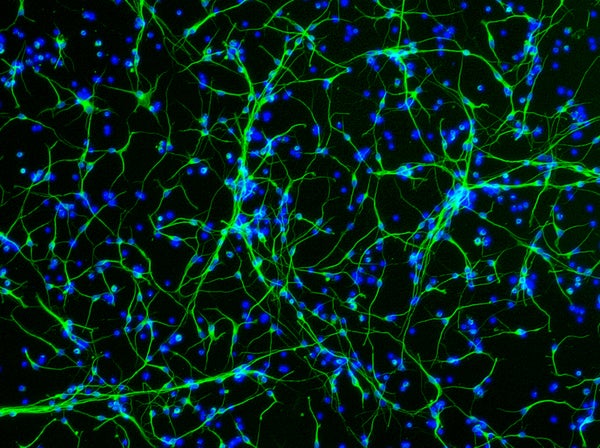The observation that the human brain churns out new neurons throughout life is one of the biggest neuroscience discoveries of the past 20 years. The idea has captured immense popular and scientific interest—not least, because of hopes the brain’s regenerative capacity might be harnessed to boost cognition or to treat injury or disease. In nonhuman animals the continued production of new neurons has been linked to improved learning and memory, and possibly even mood regulation.
But new findings in humans, reported online in Nature on Wednesday, pump the brakes on this idea. In a direct challenge to earlier studies, the authors report adults produce no new cells in the hippocampus, a key hub for processing memories.
The study signals the latest volley in a debate over whether and to what extent the human brain produces new cells in adulthood. Scientists originally believed the brain stopped making neurons at or shortly after birth. But research in the 1960s began rolling back this dogma. Emerging techniques for labeling dividing cells revealed the birth of new neurons—a process called neurogenesis—in parts of the adult rat brain. Over the next few decades scientists discovered adult neurogenesis in other species, including birds, mice and monkeys. And in a 1998 landmark study researchers reported the phenomenon in the adult human hippocampus. Another major study in 2013 corroborated those findings, estimating that about 1,400 hippocampal neurons are made daily in adult brains.
On supporting science journalism
If you're enjoying this article, consider supporting our award-winning journalism by subscribing. By purchasing a subscription you are helping to ensure the future of impactful stories about the discoveries and ideas shaping our world today.
The latest results push the pendulum back, raising eyebrows—even among the study researchers themselves. “We went into the hippocampus expecting to see many young neurons,” says senior author Arturo Alvarez-Buylla, a neuroscientist at the University of California, San Francisco. “We were surprised when we couldn’t find them.”
Together with collaborators in China, Spain and Los Angeles, Alvarez-Buylla’s team examined 59 human brain samples ranging in age from fetal stages up to 77 years, obtained either postmortem or during brain surgery. The researchers sliced the tissue, then applied various antibodies that would signal the presence of young neurons as well as dividing cells, which give rise to new neurons. They found clear evidence of new neurons forming in prenatal and neonatal samples, but this fell off sharply within the first year of life. By ages seven and 13, only a few isolated young neurons appeared. In adult samples the researchers found no new neurons.
“I feel vindicated,” says neuroscientist Pasko Rakic, a longtime, outspoken skeptic of neurogenesis in human adults. The Yale University researcher’s work suggests adult monkeys produce significantly fewer new neurons than do adult rodents. Rakic favors the idea that in primates, including humans, the absence or near absence of adult neurogenesis could help prevent disruptions to complex neural circuits. “This paper not only shows very convincing evidence of a lack of neurogenesis in the adult human hippocampus but also shows that some of the evidence presented by other studies was not conclusive,” he says.
Others not associated with the work interpret the findings in less stark terms. “It’s by far the best database that has ever been put together on cell turnover in the adult human hippocampus,” says Steven Goldman, a neurologist at the University of Rochester Medical Center and the University of Copenhagen. “The jury is still out about whether there are any new neurons being produced,” he says, adding that if there is neurogenesis, “it’s just not at the levels that have been presumed by many.” Goldman has had his doubts since the early 2000s, when his group isolated neural precursor cells from the adult human brain. These cells, although capable of producing neurons in a dish, were scarce in the brain. Goldman believes the latest study will help temper runaway expectations adult neurogenesis can be leveraged to treat patients’ memory or mood disorders.
Yet others argue it is too early to change course based on the new results. Jonas Frisén, senior author of the 2013 study, stands by his original findings. “Since it is a rare phenomenon they are looking for, they may just not have looked carefully enough,” he says. The 1,400 neurons Frisén’s team estimated arise daily comprise a small fraction of the tens of millions of hippocampal cells. To find them, his group at the Karolinska Institute in Stockholm studied people who were exposed to cold war nuclear bomb testing, and incorporated a radioactive carbon isotope into their dividing cells over many years. This cumulative measure, Frisén argues, can detect neurogenesis better than antibodies that label new neurons at a single time point.
The U.C.S.F.-led group is “not really measuring neurogenesis in this study,” adds neuroscientist Fred Gage at the Salk Institute for Biological Studies. “Neurogenesis is a process, not an event. They just took dead tissue and looked at it at that moment in time.” In their seminal 1998 study Gage and his colleagues studied the brains of people who had received as part of cancer treatment an imaging molecule that became integrated into the DNA of actively dividing cells. Gage also believes the authors used overly restrictive criteria for counting neural progenitor cells, further reducing the chances of seeing them in adults. Far from settling the debate, Gage predicts this provocative paper will intensify interest in this area of study. “There will be lots and lots more papers,” he says.
